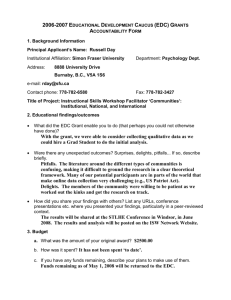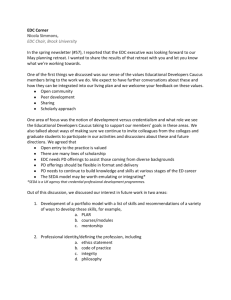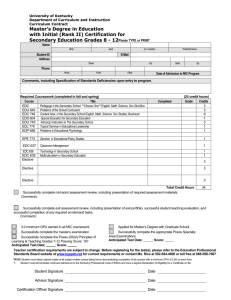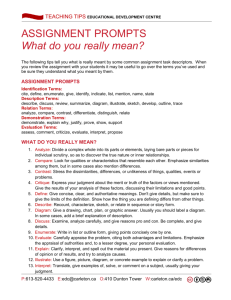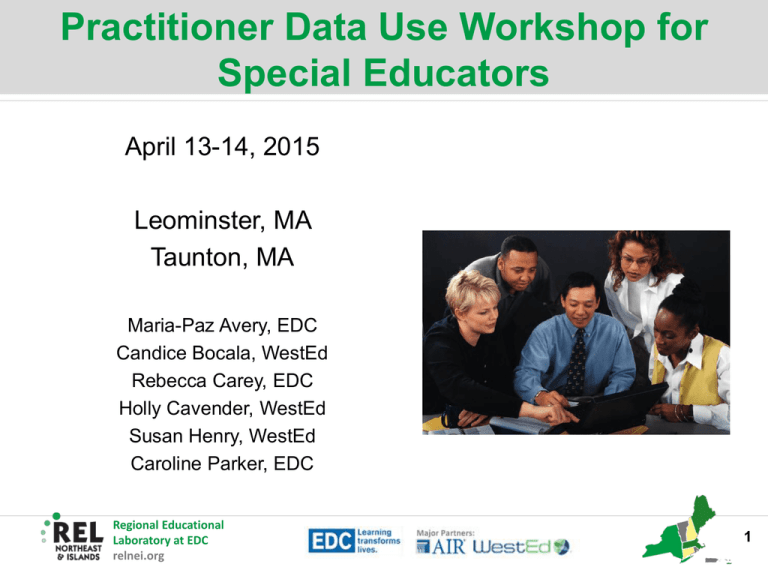
Practitioner Data Use Workshop for
Special Educators
April 13-14, 2015
Leominster, MA
Taunton, MA
Maria-Paz Avery, EDC
Candice Bocala, WestEd
Rebecca Carey, EDC
Holly Cavender, WestEd
Susan Henry, WestEd
Caroline Parker, EDC
Regional Educational
Laboratory at EDC
relnei.org
1
What is a Regional Educational
Laboratory?
• Network of 10 RELs across
the country
• Help states and districts use
research and data to inform
policy and practice with the
goal of improving student
outcomes
• Funded by USED Institute of
Education Sciences
Regional Educational
Laboratory at EDC
relnei.org
ies.ed.gov/ncee/edlabs/
2
Goals for Today
During the workshop, participants will:
• Become familiar with an inquiry framework for
interpreting data for instructional change.
• Engage in protocols to analyze data and generate
possible root causes.
• Connect analysis to action plans and monitoring results.
• Consider how to support data inquiry routines in their
own settings.
Regional Educational
Laboratory at EDC
relnei.org
3
Agenda
8:30-9:15
Welcome, Data Literacy and Inquiry Routines
9:15-10:20
Step 1: Seek Information
10:20-10:35
BREAK
10:35-11:55
Step 2: Access and Gather Data
Step 3: Analyze and Interpret Data
11:55-12:40
LUNCH
12:40-2:00
Step 4: Act
2:00-2:20
Step 5: Evaluate
2:30-2:30
BREAK
2:30-3:30
ESE Presentation: Using EdWin Analytics
Regional Educational
Laboratory at EDC
relnei.org
4
Who is in the Room?
• Stand up if you represent:
– District or Central Office
Administration
– School Administration
– Classroom Teachers
– Instructional Specialists or
Coaches
– Related Service Providers
(Speech / Language Pathology,
Occupational Therapists)
– Other?
Regional Educational
Laboratory at EDC
relnei.org
5
Turn & Talk
Introduce yourself to
others at your table.
• What data do you
encounter in your
job?
• In what format do the
data appear?
• How do you use the
data?
Regional Educational
Laboratory at EDC
relnei.org
6
Data Use and Special Education
Identification and
placement decisions
• Psycho-educational assessments
• Initial screening assessments
• Readiness and transition
planning
Instruction
• Diagnostic-prescriptive teaching
• Ongoing progress monitoring
• Modifications, accommodations,
and differentiation
School and district
improvement
• Multi-tiered systems of support
(e.g., Response to Intervention,
Positive Behavioral Interventions
& Supports)
Regional Educational
Laboratory at EDC
relnei.org
7
Moving from ‘Proving’ to ‘Improving’
• There are two different dispositions toward using data
that affect our beliefs and actions.
Proving
Using data to show specific gains or
losses in student learning
Numeric scores or rankings
More concerned with proving
effectiveness of practice
Improving
Using data to better understand student
ideas & thinking
Student work, observations
More concerned with improving and
rethinking practice, generating new
questions
(Charalambous & Silver, 2008; McLaughlin & Zarrow, 2001; Nelson, Slavit, & Deuel, 2012)
Regional Educational
Laboratory at EDC
relnei.org
8
Our Focus for Today
• Our focus for today is
using data within a
collaborative process
and predicable routine
in order to improve
student learning
outcomes.
Regional Educational
Laboratory at EDC
relnei.org
9
Turn & Talk
What is a routine?
Does your team or
school have a data
routine?
How is it working?
Regional Educational
Laboratory at EDC
relnei.org
10
Inquiry-based Routines
• Repetitive, recognizable patterns
of interdependent actions
• Inquiry supports a team’s
collective pursuit of knowledge,
insights, and understandings
around a particular question or
challenge
• Routines can enable or constrain
inquiry
Regional Educational
Laboratory at EDC
relnei.org
11
Routines that Support Learning
When a routine allows for
adaptation and creation
of new knowledge,
it can contribute to
ongoing organizational
improvement and
learning and transform
beliefs and practice.
~ Argote, 1999; Garvin, 1993
Regional Educational
Laboratory at EDC
relnei.org
12
Why a Routine?
1) Sustains team focus on an instructional issue long
enough to develop and test solutions in the classroom
• observe and discuss causal connections
• question current practices
2) Frames iterative cycles of action and reflection
• explore underlying assumptions and beliefs
• revise their conceptions of effective teaching and learning
(Achinstein, 2002; Edmondson, 2002; Stokes, 2001; Timperley, 2008)
Regional Educational
Laboratory at EDC
relnei.org
13
Turn & Talk: Reactions to the Research
• What is your reaction
to the research on
collaborative inquiry
and data use?
• Where do you have
opportunities to do
this in your work?
Write one example on chart
paper per group.
Regional Educational
Laboratory at EDC
relnei.org
14
Conceptualizing a data inquiry cycle
?
?
?
?
?
Regional Educational
Laboratory at EDC
relnei.org
15
The inquiry cycle
2. Access
and gather
data
1. Seek
information
3. Analyze
and
interpret
data
5. Evaluate
4. Act
National Forum on Education Statistics. (2012). Forum Guide to Taking Action with Education Data. (NFES 2013-801). U.S.
Department of Education. Washington, DC: National Center for Education Statistics.
Regional Educational
Laboratory at EDC
relnei.org
16
Handout: Personal data plan
template
Regional Educational
Laboratory at EDC
relnei.org
17
Seek
information
Gather
data
Interpret
data
Step 1: Guiding
questions
Act
Evaluate
2. Access
and gather
data
1. Seek
information
• What is our focus area?
• What questions can we
ask about student
learning that can be
answered by looking at
data related to this focus
area?
Regional Educational
Laboratory at EDC
relnei.org
3. Analyze
and
interpret
data
5. Evaluate
4. Act
18
Seek
information
Gather
data
Interpret
data
Act
Evaluate
Finding a focus
question
• How are our students with
disabilities performing on
early literacy assessments?
• What are your highpriority standards or
content?
• How well do our students
with disabilities understand
algebraic concepts and
procedures?
• What do you want to
know about students’
learning of that content?
• How well do our students
with disabilities write
analytically?
Regional Educational
Laboratory at EDC
relnei.org
19
Seek
information
Gather
data
Interpret
data
Discuss your
instructional focus and fill
out Step 1: Seek
Information on your
personal data plan
template.
Act
Evaluate
2. Access
and gather
data
1. Seek
information
3. Analyze
and
interpret
data
5. Evaluate
4. Act
Regional Educational
Laboratory at EDC
relnei.org
20
Please write any questions on
sticky notes and hand them to a
facilitator.
BREAK
Back at 10:35 AM
Regional Educational
Laboratory at EDC
relnei.org
21
Seek
information
Gather
data
Interpret
data
Step 2: Guiding
questions
Act
Evaluate
2. Access
and gather
data
1. Seek
information
• What data do we have and
what data can we get?
• What data are available at
different levels (classroom,
school, district, and state)?
• What do our data sources
show, and what are their
limitations?
Regional Educational
Laboratory at EDC
relnei.org
3. Analyze
and
interpret
data
5. Evaluate
4. Act
22
Seek
information
Gather
data
Drilling down
Interpret
data
Act
Evaluate
Aggregated data:
Student learning data
results compiled at the
largest level
Disaggregated data:
Separated into groups by
race/ethnicity, language,
economic level, and/or
education status
Strand data: Separated into
groups of data sets by
content areas
Item-level data: Reported by student
performance on individual test items
Student work: Artifacts that show evidence of
student thinking
Source: Love, Stiles, Mundry, & DiRanna. (2008). A Data Coach’s
Guide to Improving Learning for All Students. Corwin Press.
Regional Educational
Laboratory at EDC
relnei.org
23
Seek
information
Gather
data
Interpret
data
Act
Evaluate
Handout: Review the data’s focus and limitations
Regional Educational
Laboratory at EDC
relnei.org
24
Seek
information
Gather
data
Interpret
data
Discuss what data
sources you have and
what data sources you
need to collect, then fill
out Step 2:
Access/Gather Data on
your personal data plan
template.
Act
Evaluate
2. Access
and gather
data
1. Seek
information
3. Analyze
and
interpret
data
5. Evaluate
4. Act
Regional Educational
Laboratory at EDC
relnei.org
25
Seek
information
Gather
data
Interpret
data
Step 3: Guiding
questions
Act
Evaluate
2. Access
and gather
data
1. Seek
information
• What do we observe in
the data? What patterns
do we notice?
• What can we infer about
our students’ strengths
and challenges?
• Which challenge shall we
address?
Regional Educational
Laboratory at EDC
relnei.org
3. Analyze
and
interpret
data
5. Evaluate
4. Act
26
Two Recommendations for Step 3
1) Make the data visual by
2) Give educators a
translating tables with
framework that helps
numbers into charts and
them understand why
graphs, or highlighting
they need to describe the
areas of focus.
data first, before drawing
conclusions.
Regional Educational
Laboratory at EDC
relnei.org
27
Seek
information
Gather
data
Interpret
data
Act
Evaluate
Tips for creating data displays
Provide complete title, labels
to axes, and key
• Name of assessment
• Date
• Content area
• Grades tested
• Number of students (n=__)
Make chart simple and easy
to read
• Minimize distracting
elements (no grid lines)
• Appropriate fonts & color
• Provide data point values
where helpful
• Consistent scales when
comparisons are needed
Source: Boudett, City, & Murnane (2013). Data Wise: A Step-by-Step Guide to Using Assessment
Data to Improve Teaching and Learning. Harvard Education Press. p. 82.
Regional Educational
Laboratory at EDC
relnei.org
28
Two Recommendations for Step 3
1) Make the data visual by
2) Give educators a
translating tables with
framework that helps
numbers into charts and
them understand why
graphs, or highlighting
they need to describe the
areas of focus.
data first, before drawing
conclusions.
Regional Educational
Laboratory at EDC
relnei.org
29
Seek
information
Gather
data
Interpret
data
Act
Evaluate
I take actions based on my beliefs
I adopt beliefs
I draw conclusions
I make assumptions based on the
meanings I added
I make inferences based on the
data I selected
I select data from what I observe
Ladder of Inference
Observable data & experiences
Regional Educational
Laboratory at EDC
relnei.org
30
Data-driven dialogue
© 2008 Corwin Press. All rights reserved. From A Data Coach’s Guide to Improving Learning for All Students
by N. Love, K. E. Stiles, S. Mundry & K. DiRanna
Regional Educational
Laboratory at EDC
relnei.org
31
Select a student learning challenge
Examples:
• Based on assessments of early reading (for example,
Diagnostic Reading Assessment), students with
disabilities are scoring only 20% on letter-naming
fluency.
• Based on 7th-grade standardized math assessment
results and current benchmark assessments, 32% of
students with disabilities meet the proficiency
standard, compared with 77% of students without
disabilities.
Regional Educational
Laboratory at EDC
relnei.org
32
Seek
information
Gather
data
Interpret
data
Using your data,
discuss your
conclusions from the
data-driven dialogue,
then fill out Step 3:
Analyze/Interpret Data
on your personal data
plan template.
Regional Educational
Laboratory at EDC
relnei.org
Act
Evaluate
2. Access
and gather
data
1. Seek
information
3. Analyze
and
interpret
data
5. Evaluate
4. Act
33
Please write any questions on
sticky notes and hand them to a
facilitator.
LUNCH
Back at 12:40 PM
Regional Educational
Laboratory at EDC
relnei.org
34
Seek
information
Gather
data
Interpret
data
Act
Evaluate
Step 4: Guiding
questions
2. Access
and gather
data
1. Seek
information
• What goals do we have for
our students’ learning?
• What are the root causes
that might have led to the
patterns seen in student
performance?
• What changes or action
steps will address the goals
we set for our students’
learning?
Regional Educational
Laboratory at EDC
relnei.org
3. Analyze
and
interpret
data
5. Evaluate
4. Act
35
Seek
information
Gather
data
Interpret
data
S
• Specific
M
• Measurable
A
• Achievable
R
• Realistic
T
• Timely
Regional Educational
Laboratory at EDC
relnei.org
Act
Evaluate
Now that you have
identified a student learning
challenge, consider what
you would want to see if
students were doing well.
Example: By May 2015, all 4th
grade students with learning
disabilities will have improved
their reading fluency rates by
10 words correct per minute,
based on the Read Naturally
Program.
36
Seek
information
Gather
data
Interpret
data
S
• Specific
M
• Measurable
A
• Achievable
R
• Realistic
T
• Timely
Regional Educational
Laboratory at EDC
relnei.org
Act
Evaluate
Draft a SMART student
learning goal that
addresses the need you
identified during datadriven dialogue.
Exchange your goal with
another participant or
team and provide
feedback.
37
Handout: Fishbone diagram
Regional Educational
Laboratory at EDC
relnei.org
38
Fishbone cause & effect analysis,
round 1
What student
learning challenge or
conclusions from
data analysis are we
examining?
Regional Educational
Laboratory at EDC
relnei.org
What categories at
our school are
related to this? (for
example, curriculum,
assessment)
What are potential
causes? Are there
patterns or trends in
the causes?
39
Handout: Fishbone diagram
Category: Teacher supports
Possible root cause: Regular ed
teachers, special educator, and
occupational therapist do not
have regular check in times to
collaborate on interventions for
students with sensory processing
issues.
Regional Educational
Laboratory at EDC
relnei.org
40
Fishbone cause & effect analysis,
round 2
What student
learning challenge
or conclusions
from data analysis
are we examining?
What categories at
our school are
related to this?
(for example,
curriculum,
assessment)
Regional Educational
Laboratory at EDC
relnei.org
What are potential
causes? Are there
patterns or trends
in the causes?
What action steps
might address the
patterns in the
causes?
41
Handout: Fishbone diagram
Category: Teacher supports
Possible root cause: Regular ed
teachers, special educator, and
occupational therapist do not
have regular check in times to
collaborate on interventions for
students with sensory processing
issues.
Action step: Have the
OT join the grade
level common
planning meetings
once a month.
Regional Educational
Laboratory at EDC
relnei.org
42
Seek
information
Gather
data
Interpret
data
Discuss possible root
causes and
corresponding action
steps using the Fishbone
diagram.
Prioritize your top action
steps, then fill out Step 4:
Act on your personal data
plan template.
Regional Educational
Laboratory at EDC
relnei.org
Act
Evaluate
2. Access
and gather
data
1. Seek
information
3. Analyze
and
interpret
data
5. Evaluate
4. Act
43
Seek
information
Gather
data
Interpret
data
Step 5: Guiding
questions
Act
Evaluate
2. Access
and gather
data
1. Seek
information
• How effectively has the
initial issue been
resolved?
• What new concerns have
arisen?
• Should we continue with
our action plan or choose
a new area of focus?
Regional Educational
Laboratory at EDC
relnei.org
3. Analyze
and
interpret
data
5. Evaluate
4. Act
44
Seek
information
Gather
data
Interpret
data
Act
Evaluate
Considerations:
• Evidence of next steps in the action plan
• Documentation of how to monitor progress
– What data will be collected?
– When will that data be brought back for discussion?
• Ways for the teachers or team to check in on action
steps and reflect on progress
What evidence do we have
about what is working?
What are we learning?
What resources do we need?
Regional Educational
Laboratory at EDC
relnei.org
45
Seek
information
Gather
data
Interpret
data
Discuss how you might
monitor or evaluate your
action steps, then fill out
the first question only in
Step 5: Evaluate on your
personal data plan
template.
Act
Evaluate
2. Access
and gather
data
1. Seek
information
3. Analyze
and
interpret
data
5. Evaluate
4. Act
Regional Educational
Laboratory at EDC
relnei.org
46
Discussion: Taking Next Steps
• What were your key
takeaways from this
workshop?
• What will you apply from
what you have learned?
On an index card, write 2-3
ideas for how to use what
you have learned in your
work.
Regional Educational
Laboratory at EDC
relnei.org
47
REL-NEI Resources
• Download the Practitioner Data Use in Schools:
Workshop Toolkit (includes facilitator guide, handouts,
and slides)
• Participate in the self-paced online workshop:
Understanding Data Use to Improve Instruction
• Access both resources at:
http://www.relnei.org/publications/practitioner-data-usetoolkit.html
Regional Educational
Laboratory at EDC
relnei.org
48
Questions?
Raise your hand or
write your question on
a sticky note and hand
it to a facilitator.
Regional Educational
Laboratory at EDC
relnei.org
49
Goals for today—revisited
During the workshop, participants will:
• Become familiar with an inquiry framework for
interpreting data for instructional change.
• Engage in protocols to analyze data and generate
possible root causes.
• Connect analysis to action plans and monitoring results.
• Consider how to support data inquiry routines in their
own settings.
Regional Educational
Laboratory at EDC
relnei.org
50
Thank you!
Maria-Paz Avery, mavery@edc.org
Candice Bocala, cbocala@wested.org
Rebecca Carey, rcarey@edc.org
Holly Cavender, hcavend@wested.org
Susan Henry, shenry2@wested.org
Caroline Parker, cparker@wested.org
Regional Educational
Laboratory at EDC
relnei.org
51
References & Resources
Argote, L. (1999). Organizational learning: Creating, retaining, and transferring knowledge. Norwell, MA: Kluwer.
Achinstein, B. (2002). Conflict amid community: The micropolitics of teacher collaboration. Teachers College Record, 104(3),
421–455. Retrieved
from http://eric.ed.gov/?q=Conflict+amid+community%3a+The+micropolitics+of+teacher+collaboration&id=EJ649782.
Boudett, K. P., City, E. A., & Murnane, R. J. (Eds.) (2013). Data wise: A step-by-step guide to using assessment results to
improve teaching and learning, revised and expanded edition. Cambridge, MA: Harvard Education Press.
Charalambous, C., & Silver, E. A. (2008, January). Shifting from proving to improving: Using assessment as an integral part
of instruction. Paper presented at the annual meeting of the Association of Mathematics Teacher Educators, Tulsa, OK.
Copland, M. A. (2003). Leadership of inquiry: Building and sustaining capacity for school improvement. Educational
Evaluation and Policy Analysis, 25(4), 375–395. Retrieved from
http://eric.ed.gov/?q=Leadership+of+inquiry%3a+Building+and+sustaining+capacity+for+school+improvement&id=EJ782423
Doran, G. T. (1981). There's a S.M.A.R.T. way to write management's goals and objectives. Management Review, 70(11),
35–36.
Edmondson, A. (2002). The local and variegated nature of learning in organizations: A group- level perspective.
Organization Science, 13(2), 128–146.
Gallimore, R., Ermeling, B., Saunders, W., & Goldenberg, C. (2009). Moving the learning of teaching closer to practice: Teacher
education implications of school-based inquiry teams. The Elementary School Journal, 109(5), 537–553. Retrieved from
http://eric.ed.gov/?q=Moving+the+learning+of+teaching+closer+to+practice%3a+Teacher+education+implications+of+schoolbased+inquiry+teams&id=EJ844058
Garvin, D.A. (1993). Building a learning organization. Harvard Business Review, 71(4), 78-91.
Regional Educational
Laboratory at EDC
relnei.org
52
References & Resources
Hamilton, L., Halverson, R., Jackson, S., Mandinach, E., Supovitz, J., & Wayman, J. (2009). Using student
achievement data to support instructional decision making (NCEE 2009-4067). Washington, DC: National Center for
Education Evaluation and Regional Assistance, Institute of Education Sciences, U.S. Department of Education.
Retrieved from http://ies.ed.gov/ncee/wwc/publications/practiceguides/
Love, N., Stiles, K. E., Mundry, S., and DiRanna, K. (2008). The data coach’s guide to improving learning for all
students: Unleashing the power of collaborative inquiry. Thousand Oaks, CA: Corwin Press.
McLaughlin, M. W., & Zarrow, J. (2001). Teachers engaged in evidence-based reform: Trajectories of teachers’ inquiry,
analysis, and action. In A. Lieberman & L. Miller (Eds.), Teachers caught in the action: Professional development that
matters (pp. 79–101). New York: Teachers College Press.
National Forum on Education Statistics. (2012). Forum Guide to Taking Action with Education Data. (NFES 2013-801).
U.S. Department of Education. Washington, DC: National Center for Education Statistics. Retrieved from
http://nces.ed.gov/pubs2013/2013801.pdf
Nelson, T. H., Slavit, D., & Deuel, A. (2012). Two dimensions of an inquiry stance toward student-learning data.
Teachers College Record (114). Retrieved from
http://eric.ed.gov/?q=Two+dimensions+of+an+inquiry+stance+toward+student-learning+data&id=EJ1001974
Stokes, L. (2001). Lessons from an inquiring school: Forms of inquiry and conditions for teacher learning. In A.
Lieberman & L. Miller (Eds.), Teachers caught in the action: Professional development that matters (pp. 141–158). New
York: Teachers College Press.
Timperley, H. (2008). Evidence-informed conversations: Making a difference to student achievement. In L. M. Earl & H.
Timperley (Eds.), Professional learning conversations: Challenges in using evidence for improvement (Vol. 1, pp. 69–
79). Dordrecht: Springer.
Regional Educational
Laboratory at EDC
relnei.org
53

